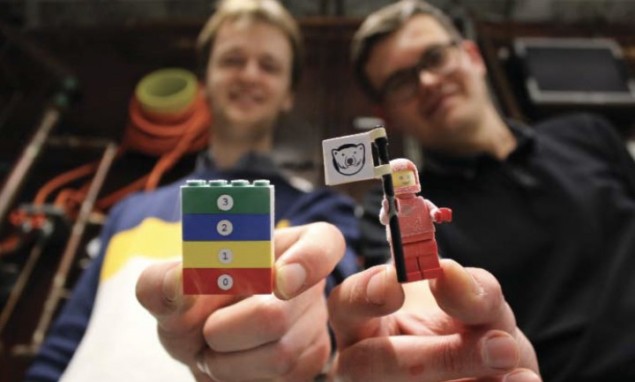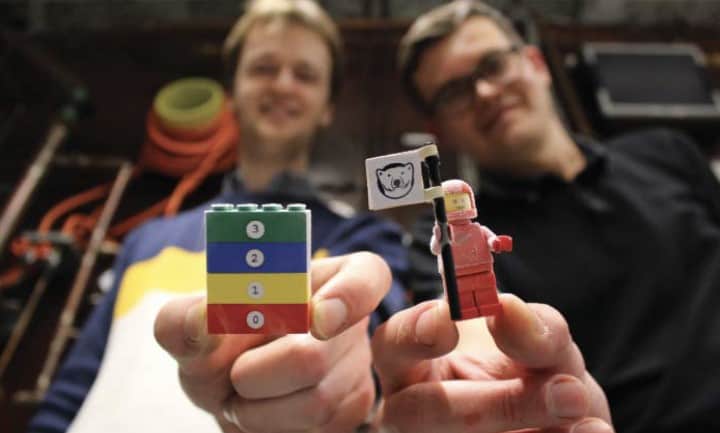
Despite the impact of the COVID-19 pandemic, physicists have still found time to carry out research that touches on the quirkier side of science. Here is our pick of the 10 best, not in any particular order.
Low-temperature LEGO
Condensed-matter physicists like to put materials under extreme conditions to tease out their interesting properties. So why not see if anything interesting happens with everyday objects? That is exactly what physicists at Lancaster University did when they put four LEGO bricks into their dilution refrigerator and cooled them to a chilly 70 mK. LEGO bricks are made from a material called Acrylonitrile Butadiene Styrene (ABS). The team found that this acts as a better insulator than many well-known bulk-insulator materials such as the glass-ceramic Macor or the plastic-based Vespel . Given that ABS is relatively cheap, the team says that 3D-printed scaffolds of the material could be an alternative to current materials used to build low-temperature equipment. Being a playful group of physicists, they also put a LEGO minifigure into the refrigerator, which not only survived the deep freeze but has also become the “world’s first LEGO cryonaut”.
Sag, settle, curl
Dried spaghetti has long perplexed physicists due to its tendency to break into three pieces when bent, rather than two. Nathaniel Goldberg and Oliver O’Reilly of the University of California, Berkeley, tackled another puzzle related to the stringy pasta. When placed in a pot of boiling water, a spaghetti strand will first sag and then settle on the pot’s bottom before finally curving in on itself into a U-shape. The researchers identify these three separate states as sagging, settling and curling, with Goldberg and O’Reilly creating a model that could predict the mechanical behaviour of the pasta as it cooks. The duo says that the model could be useful for the food-production industry and that future research could focus on the deformation of other types of pasta such as rigatoni or lasagne. It seems like the pasta-bilities are endless.
Grinding it out
You’d think that making an espresso is easy – just force hot, high-pressure water through a bed of coffee grounds. Some of us have become coffee connoisseurs during lockdown, but even for skilled baristas operating top-of-the-range coffee machines, creating cups of espresso that taste consistent from one to the next is tricky. So to discover the secret of the perfect espresso, a team of researchers led by mathematician Jamie Foster from the University of Portsmouth created a model to describe the espresso-making process. Espresso coffee normally comes in a fine grind, which maximizes the surface area of coffee that is in contact with the water. That, in theory, should result in a strong cup of coffee that gets the most flavour out of the grounds. But by examining different grinds of coffee, Foster and pals discovered that if the coffee is too fine, the water can be prevented from reaching all of the coffee grounds. The researchers’ theory is currently being tested at a coffee shop in Eugene, Oregon – which makes a mocha-ry of the notion that Americans aren’t interested in a decent brew.
Parking theory, part 2
Finding the best place to park your car might be the least of your worries during the current global COVID-19 pandemic. But when life does finally return to normal and you’re searching for that perfect car-park spot, US physicists Paul Krapivsky and Sidney Redner have some advice. Last year they examined whether it’s better to park far from your destination (which should be easy but then require a long walk) or to park nearby (which should be harder but require only a short walk). Their conclusion was that a “prudent” strategy is best, in which you park in the first gap of cars you come across but take the spot nearest to the venue. This year the duo formulated a general rule for this prudent strategy. According to Krapivsky and Redner, drivers who observe a particular rule will have a probability of finding the best spot that can be as high as 25%. Trouble is, their calculation depends on every driver observing the rules, which as we know isn’t guaranteed. And it assumes a 1D parking lot, which is the kind of place that only exists in a physicist’s imagination.

Backgrounds to the fore
With video-conference services like Zoom all the rage this year, you still might want to impress your friends and colleagues with a background from the Perimeter Institute for Theoretical Physics (PI) in Canada. As one of the world’s top centres for physics research, it released nine science-themed images for use as a backdrop when you don’t want colleagues seeing the dirty-laundry basket, rioting kids or peeling wallpaper behind you. The images include an artist’s impression of two colliding black holes, a dark-matter map of the cosmos as well as an exterior shot of the PI building in Waterloo, Ontario. Of course, PI isn’t alone – other Zoom backgrounds are available too, including images of the ATLAS detector at the CERN particle-physics lab and shots taken by the Hubble Space Telescope.
Friday on my mind
Come Dine with Me is the brilliant British TV show in which amateur home cooks take turns hosting a dinner party for each other throughout the course of a week. Each dinner is scored in private by the other contestants on the evening it’s served and whoever racks up the highest score at the end of the week wins a cash prize. Two physicists from the University of Hamburg analysed results from 2268 episodes of the German version of the show – Das Perfekte Dinner – and concluded that you have more chance of winning if you host a dinner later in the week. Cook on a Monday and you might as well just open a jar of sauerkraut. Peter Blum and Marc Wenskat say that their finding is an example of the “secretary problem”, which arises when things are rated consecutively using the same criteria. Apparently, the application of those criteria change as each scoring occurs, skewing the results. “When competing, one should always carefully choose when to compete,” the authors write. So if you want perfection, go last.
The bottom line
Researchers revisited a classic problem in the animal kingdom this year: why can penguins poo such large distances? In 2003 researchers from Germany, Finland and Hungary – who bagged an IgNobel prize in 2005 for their efforts – found that some penguins can fire their excreta as far as 40 cm, allowing these aquatic birds to continue to nurture their eggs without sitting in a sea of faeces. Researchers in Japan modified this pooping model to calculate the maximum distance that a penguin could manage to fling their dung when at a certain height. Thanks to the penguins’ “strong rectal pressure”, which they calculate to be higher than previous work, the team finds that the maximum distance is 1.34 m. The team says this information could be “useful” for zookeepers, who would know just how far away to stand to avoid getting hit by the firing faeces. So next time you visit the penguin enclosure – do keep your faecal distancing.
Cubic earth
We’ve long dismissed the notion developed by the Greek philosopher Plato that the universe is made of five types of matter: earth, air, fire, water and the cosmos. Each was described with a particular geometry: a cube in the case of earth. However, new research shows that Plato might have been onto something after scientists in the US and Hungary measured and analysed fragmentation patterns in around 100 rocks that they collected as well as thousands from datasets collected by others. To their surprise, they found that the resulting shape of the fragments is indeed a cube. “It turns out that Plato’s conception about the element earth being made up of cubes is, literally, the statistical average model for real earth,” says geophysicist Douglas Jerolmack from University of Pennsylvania. “And that is just mind-blowing.”
Fair slices

What’s the fairest way to slice up a watermelon? Physicists in Belgium, France and Italy tackled the problem using geometry and calculus. After cutting the whole watermelon in half along its length and then in the middle to yield four equal quarters, the researchers discovered that this “half rule” fell away when then trying to slice the watermelon up into equal thin portions. Instead, they found a “2/3 rule”. So for a spheroid of length 10 cm, for two slices, the first slice should be made at 3.5 cm along the length but for three slices, the first slice should be 2.1 cm and the second 4.2 cm. After doing the calculations, the researchers tested them on a 4 kg watermelon and used Archimedes’ principle to confirm that the slice volumes were equal. Eureka!
Borderline collider
And finally, in 1977 the Nobel-prize-winning physicist Leon Lederman published a tongue-in-cheek proposal to build a collider using existing subway tunnels in New York. The city was then in financial crisis and Lederman, who died in 2018, reckoned that physicists could acquire the tunnels for a knock-down price. It never happened, of course, but his proposal has now inspired Caltech physicist David Hitlin to propose building another collider to address the politically controversial wall along the US–Mexican border. In a preprint paper, Hitlin describes how long, straight sections of the border between the states of Sonora and Arizona could be blocked by a huge linear particle collider. Stretching some 300 km long, he reckons the machine could achieve a centre-of-mass energy of 5 TeV. The proposed International Linear Collider (ILC) in Japan, in contrast, would be a mere 20 km long and have an initial energy of just 250 GeV. And what would Hitlin call the facility if it was built? The TrumpILC, of course.
You can be sure that next year will throw up its fair share of quirky stories from the world of physics. See you in 2021!
